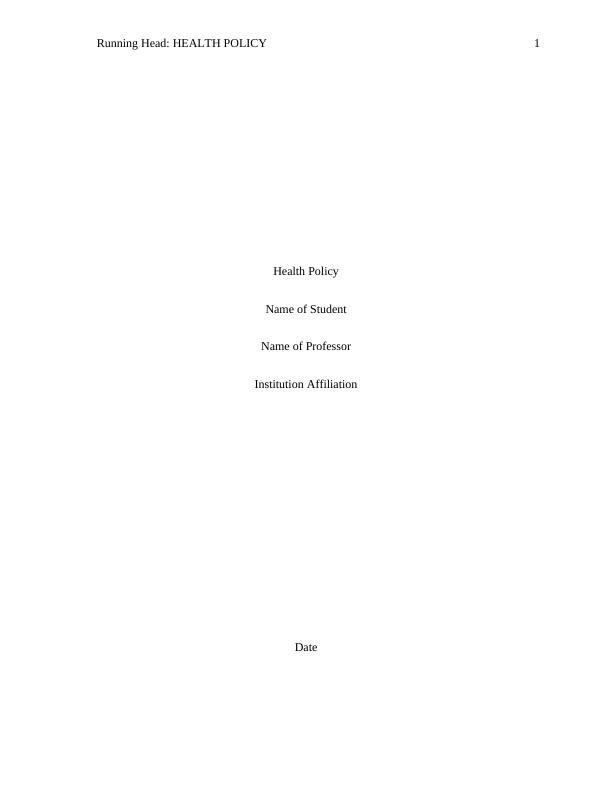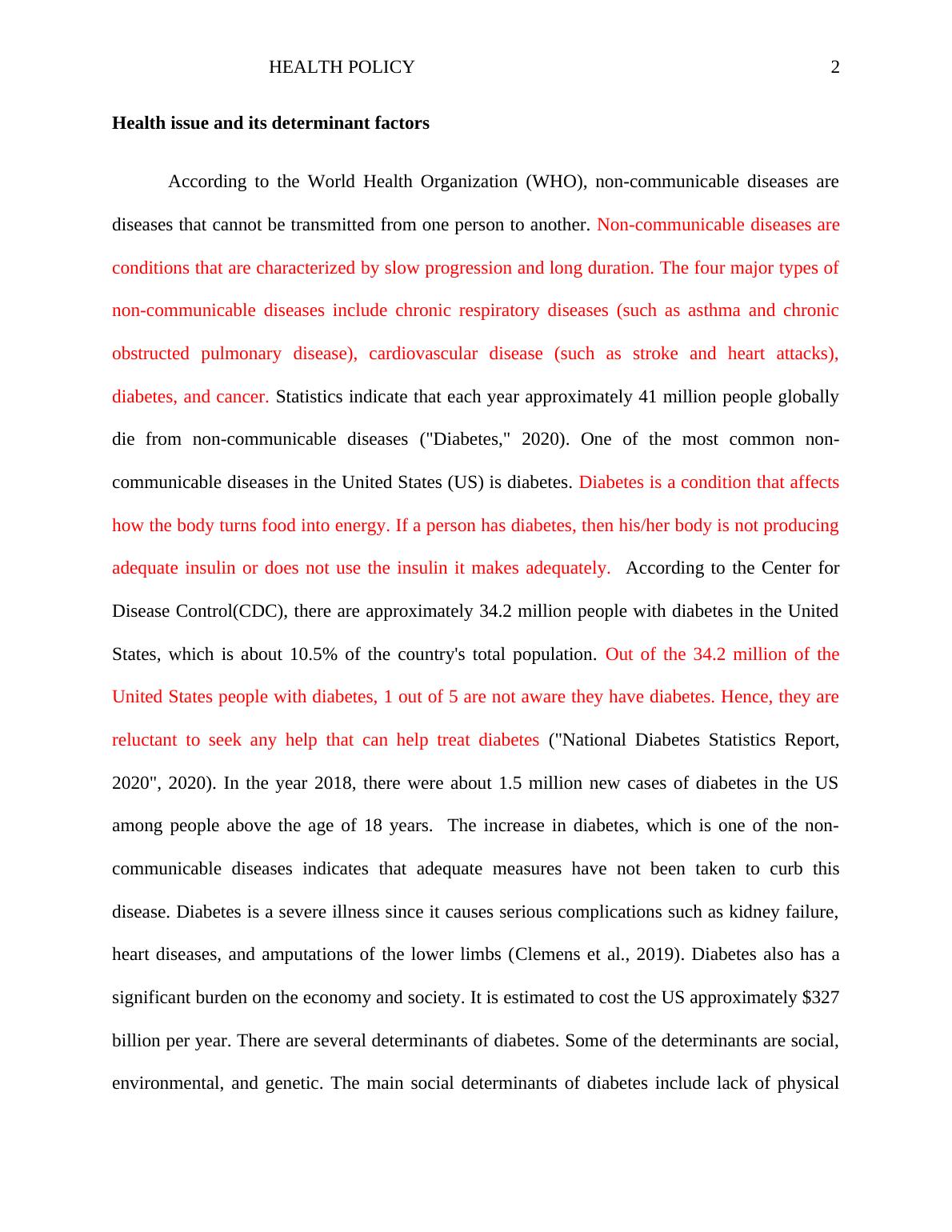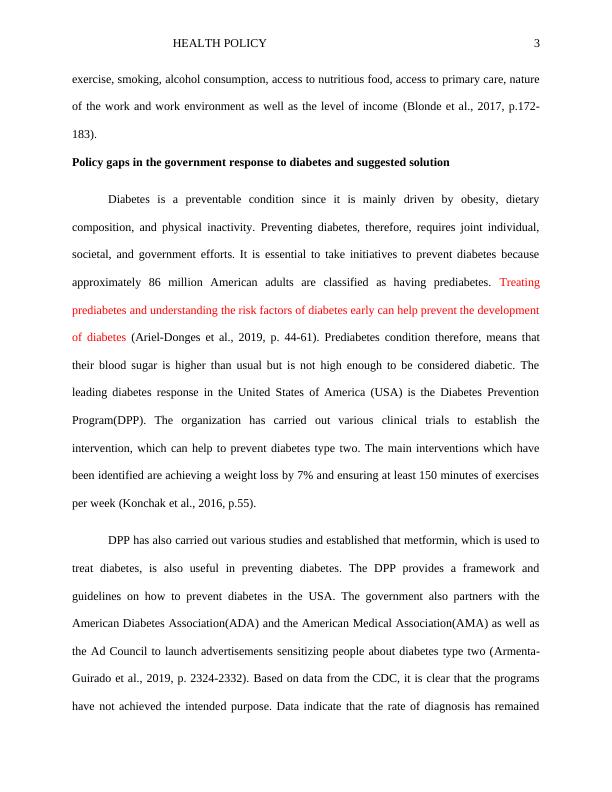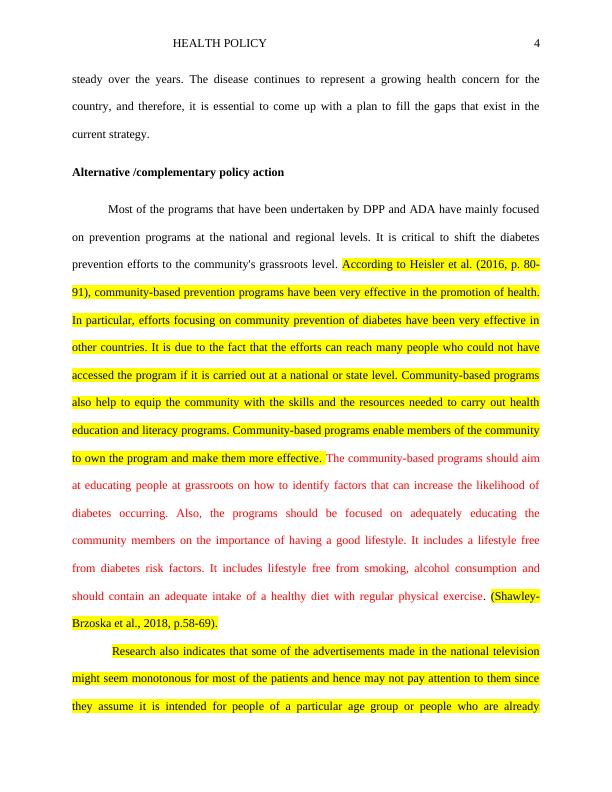Assignment on Health Issue and its Determinant Factors
Added on 2022-09-25
15 Pages4671 Words21 Views
Running Head: HEALTH POLICY 1
Health Policy
Name of Student
Name of Professor
Institution Affiliation
Date
Health Policy
Name of Student
Name of Professor
Institution Affiliation
Date

HEALTH POLICY 2
Health issue and its determinant factors
According to the World Health Organization (WHO), non-communicable diseases are
diseases that cannot be transmitted from one person to another. Non-communicable diseases are
conditions that are characterized by slow progression and long duration. The four major types of
non-communicable diseases include chronic respiratory diseases (such as asthma and chronic
obstructed pulmonary disease), cardiovascular disease (such as stroke and heart attacks),
diabetes, and cancer. Statistics indicate that each year approximately 41 million people globally
die from non-communicable diseases ("Diabetes," 2020). One of the most common non-
communicable diseases in the United States (US) is diabetes. Diabetes is a condition that affects
how the body turns food into energy. If a person has diabetes, then his/her body is not producing
adequate insulin or does not use the insulin it makes adequately. According to the Center for
Disease Control(CDC), there are approximately 34.2 million people with diabetes in the United
States, which is about 10.5% of the country's total population. Out of the 34.2 million of the
United States people with diabetes, 1 out of 5 are not aware they have diabetes. Hence, they are
reluctant to seek any help that can help treat diabetes ("National Diabetes Statistics Report,
2020", 2020). In the year 2018, there were about 1.5 million new cases of diabetes in the US
among people above the age of 18 years. The increase in diabetes, which is one of the non-
communicable diseases indicates that adequate measures have not been taken to curb this
disease. Diabetes is a severe illness since it causes serious complications such as kidney failure,
heart diseases, and amputations of the lower limbs (Clemens et al., 2019). Diabetes also has a
significant burden on the economy and society. It is estimated to cost the US approximately $327
billion per year. There are several determinants of diabetes. Some of the determinants are social,
environmental, and genetic. The main social determinants of diabetes include lack of physical
Health issue and its determinant factors
According to the World Health Organization (WHO), non-communicable diseases are
diseases that cannot be transmitted from one person to another. Non-communicable diseases are
conditions that are characterized by slow progression and long duration. The four major types of
non-communicable diseases include chronic respiratory diseases (such as asthma and chronic
obstructed pulmonary disease), cardiovascular disease (such as stroke and heart attacks),
diabetes, and cancer. Statistics indicate that each year approximately 41 million people globally
die from non-communicable diseases ("Diabetes," 2020). One of the most common non-
communicable diseases in the United States (US) is diabetes. Diabetes is a condition that affects
how the body turns food into energy. If a person has diabetes, then his/her body is not producing
adequate insulin or does not use the insulin it makes adequately. According to the Center for
Disease Control(CDC), there are approximately 34.2 million people with diabetes in the United
States, which is about 10.5% of the country's total population. Out of the 34.2 million of the
United States people with diabetes, 1 out of 5 are not aware they have diabetes. Hence, they are
reluctant to seek any help that can help treat diabetes ("National Diabetes Statistics Report,
2020", 2020). In the year 2018, there were about 1.5 million new cases of diabetes in the US
among people above the age of 18 years. The increase in diabetes, which is one of the non-
communicable diseases indicates that adequate measures have not been taken to curb this
disease. Diabetes is a severe illness since it causes serious complications such as kidney failure,
heart diseases, and amputations of the lower limbs (Clemens et al., 2019). Diabetes also has a
significant burden on the economy and society. It is estimated to cost the US approximately $327
billion per year. There are several determinants of diabetes. Some of the determinants are social,
environmental, and genetic. The main social determinants of diabetes include lack of physical

HEALTH POLICY 3
exercise, smoking, alcohol consumption, access to nutritious food, access to primary care, nature
of the work and work environment as well as the level of income (Blonde et al., 2017, p.172-
183).
Policy gaps in the government response to diabetes and suggested solution
Diabetes is a preventable condition since it is mainly driven by obesity, dietary
composition, and physical inactivity. Preventing diabetes, therefore, requires joint individual,
societal, and government efforts. It is essential to take initiatives to prevent diabetes because
approximately 86 million American adults are classified as having prediabetes. Treating
prediabetes and understanding the risk factors of diabetes early can help prevent the development
of diabetes (Ariel-Donges et al., 2019, p. 44-61). Prediabetes condition therefore, means that
their blood sugar is higher than usual but is not high enough to be considered diabetic. The
leading diabetes response in the United States of America (USA) is the Diabetes Prevention
Program(DPP). The organization has carried out various clinical trials to establish the
intervention, which can help to prevent diabetes type two. The main interventions which have
been identified are achieving a weight loss by 7% and ensuring at least 150 minutes of exercises
per week (Konchak et al., 2016, p.55).
DPP has also carried out various studies and established that metformin, which is used to
treat diabetes, is also useful in preventing diabetes. The DPP provides a framework and
guidelines on how to prevent diabetes in the USA. The government also partners with the
American Diabetes Association(ADA) and the American Medical Association(AMA) as well as
the Ad Council to launch advertisements sensitizing people about diabetes type two (Armenta-
Guirado et al., 2019, p. 2324-2332). Based on data from the CDC, it is clear that the programs
have not achieved the intended purpose. Data indicate that the rate of diagnosis has remained
exercise, smoking, alcohol consumption, access to nutritious food, access to primary care, nature
of the work and work environment as well as the level of income (Blonde et al., 2017, p.172-
183).
Policy gaps in the government response to diabetes and suggested solution
Diabetes is a preventable condition since it is mainly driven by obesity, dietary
composition, and physical inactivity. Preventing diabetes, therefore, requires joint individual,
societal, and government efforts. It is essential to take initiatives to prevent diabetes because
approximately 86 million American adults are classified as having prediabetes. Treating
prediabetes and understanding the risk factors of diabetes early can help prevent the development
of diabetes (Ariel-Donges et al., 2019, p. 44-61). Prediabetes condition therefore, means that
their blood sugar is higher than usual but is not high enough to be considered diabetic. The
leading diabetes response in the United States of America (USA) is the Diabetes Prevention
Program(DPP). The organization has carried out various clinical trials to establish the
intervention, which can help to prevent diabetes type two. The main interventions which have
been identified are achieving a weight loss by 7% and ensuring at least 150 minutes of exercises
per week (Konchak et al., 2016, p.55).
DPP has also carried out various studies and established that metformin, which is used to
treat diabetes, is also useful in preventing diabetes. The DPP provides a framework and
guidelines on how to prevent diabetes in the USA. The government also partners with the
American Diabetes Association(ADA) and the American Medical Association(AMA) as well as
the Ad Council to launch advertisements sensitizing people about diabetes type two (Armenta-
Guirado et al., 2019, p. 2324-2332). Based on data from the CDC, it is clear that the programs
have not achieved the intended purpose. Data indicate that the rate of diagnosis has remained

HEALTH POLICY 4
steady over the years. The disease continues to represent a growing health concern for the
country, and therefore, it is essential to come up with a plan to fill the gaps that exist in the
current strategy.
Alternative /complementary policy action
Most of the programs that have been undertaken by DPP and ADA have mainly focused
on prevention programs at the national and regional levels. It is critical to shift the diabetes
prevention efforts to the community's grassroots level. According to Heisler et al. (2016, p. 80-
91), community-based prevention programs have been very effective in the promotion of health.
In particular, efforts focusing on community prevention of diabetes have been very effective in
other countries. It is due to the fact that the efforts can reach many people who could not have
accessed the program if it is carried out at a national or state level. Community-based programs
also help to equip the community with the skills and the resources needed to carry out health
education and literacy programs. Community-based programs enable members of the community
to own the program and make them more effective. The community-based programs should aim
at educating people at grassroots on how to identify factors that can increase the likelihood of
diabetes occurring. Also, the programs should be focused on adequately educating the
community members on the importance of having a good lifestyle. It includes a lifestyle free
from diabetes risk factors. It includes lifestyle free from smoking, alcohol consumption and
should contain an adequate intake of a healthy diet with regular physical exercise. (Shawley-
Brzoska et al., 2018, p.58-69).
Research also indicates that some of the advertisements made in the national television
might seem monotonous for most of the patients and hence may not pay attention to them since
they assume it is intended for people of a particular age group or people who are already
steady over the years. The disease continues to represent a growing health concern for the
country, and therefore, it is essential to come up with a plan to fill the gaps that exist in the
current strategy.
Alternative /complementary policy action
Most of the programs that have been undertaken by DPP and ADA have mainly focused
on prevention programs at the national and regional levels. It is critical to shift the diabetes
prevention efforts to the community's grassroots level. According to Heisler et al. (2016, p. 80-
91), community-based prevention programs have been very effective in the promotion of health.
In particular, efforts focusing on community prevention of diabetes have been very effective in
other countries. It is due to the fact that the efforts can reach many people who could not have
accessed the program if it is carried out at a national or state level. Community-based programs
also help to equip the community with the skills and the resources needed to carry out health
education and literacy programs. Community-based programs enable members of the community
to own the program and make them more effective. The community-based programs should aim
at educating people at grassroots on how to identify factors that can increase the likelihood of
diabetes occurring. Also, the programs should be focused on adequately educating the
community members on the importance of having a good lifestyle. It includes a lifestyle free
from diabetes risk factors. It includes lifestyle free from smoking, alcohol consumption and
should contain an adequate intake of a healthy diet with regular physical exercise. (Shawley-
Brzoska et al., 2018, p.58-69).
Research also indicates that some of the advertisements made in the national television
might seem monotonous for most of the patients and hence may not pay attention to them since
they assume it is intended for people of a particular age group or people who are already

End of preview
Want to access all the pages? Upload your documents or become a member.
Related Documents
Diabetes and Its Impact Over US Assignment 2022lg...
|10
|2622
|24
Nursing Community Health Assessmentlg...
|12
|2964
|15
Community Health and Disease Preventionlg...
|13
|3210
|71
Diabetes Type II: Prevalence, Risk Factors, and Strategies for Preventionlg...
|6
|1623
|410
Type 2 Diabetes: Causes, Complications, and Managementlg...
|13
|4074
|122
The rate of other chronic health issuelg...
|9
|2700
|11
